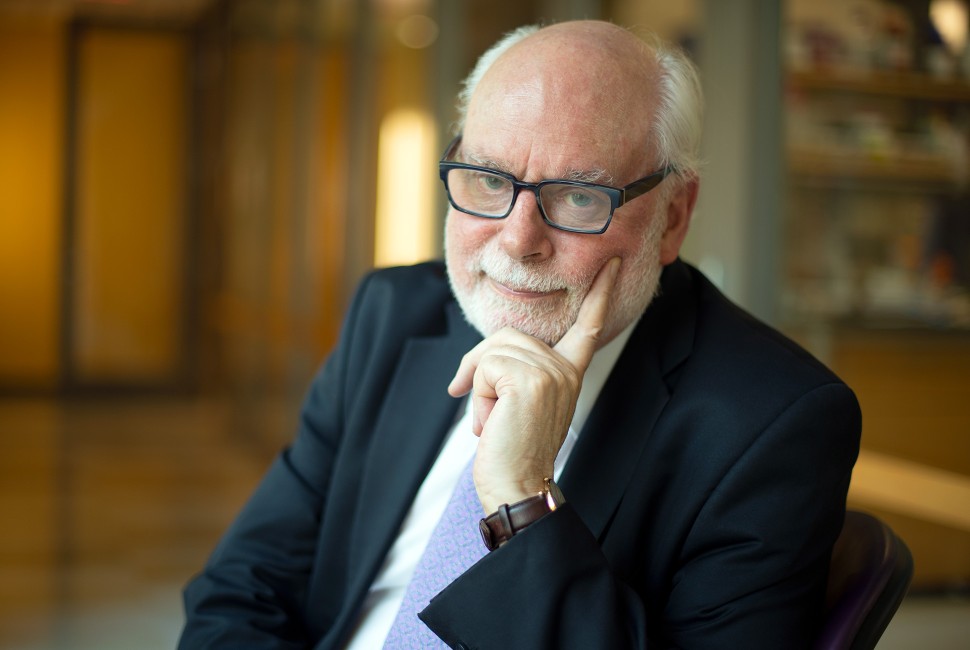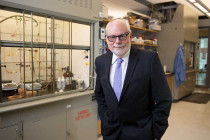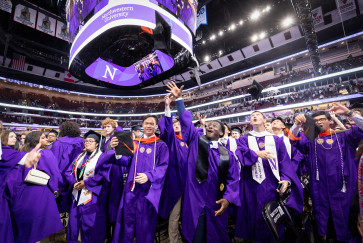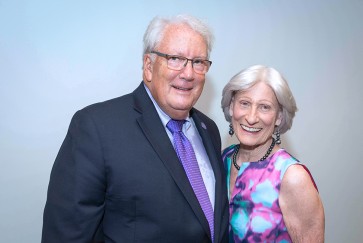Nobel laureate Sir Fraser Stoddart, a Board of Trustees Professor at Northwestern University, died Dec. 30. He was 82.
Stoddart, a pioneer in the fields of nanoscience and organic chemistry, was an outsized figure on the Evanston campus and on campuses he visited around the globe. By introducing an additional type of bond — the mechanical bond — into chemical compounds, Stoddart became one of the few chemists to have opened a new field of chemistry during the past 30 years.
His work on molecular recognition and self-assembly and his subsequent introduction of template-directed routes to mechanically interlocked molecules dramatically changed the way chemists make soft materials.
Throughout his long career of research and teaching, Stoddart mentored a diverse group of more than 500 graduate and postdoctoral students from around the world. Gregarious and thoughtful, he particularly cherished this work and the resulting relationships, many of them lifelong.
“Fraser was a giant in fields of nanoscience and organic chemistry, but his influence was equally impressive in the classrooms and labs on our campus,” said Northwestern President Michael Schill. “He was incredibly generous with his time and mentored so many students and faculty, helping pave important new paths of inquiry and discovery. His impact on our university — and the world — was enormous.”
His impact on our university — and the world — was enormous.”
Omar Faha, the Charles E. and Emma H. Morrison Professor in Chemistry at Northwestern and chair of the department, said beyond his scientific brilliance, Stoddart was a steadfast friend and mentor, always generous with his time, wisdom and encouragement. “His contributions to our community went far beyond his accolades, as he supported and elevated each of us through his boundless energy and spirit.”
Since 2023, Stoddart was the Chair Professor of Chemistry at the University of Hong Kong.
A Northwestern Nobel
Stoddart received the Nobel Prize in Chemistry in 2016, along with Jean-Pierre Sauvage and Bernard L. Feringa, “for the design and synthesis of molecular machines.” The Royal Swedish Academy of Sciences credited them with developing “molecules with controllable movements, which can perform a task when energy is added.”
“The development of computing demonstrates how the miniaturization of technology can lead to a revolution,” the academy said in its announcement. “The 2016 Nobel Laureates in Chemistry have miniaturized machines and taken chemistry to a new dimension.”
For his part, Stoddart was awarded the prize because, the academy said, in 1991 he developed a rotaxane. He threaded a molecular ring onto a thin molecular axle and demonstrated that the ring was able to move along the axle. Among his developments based on rotaxanes are a molecular lift, a molecular muscle and a molecule-based computer chip.
Stoddart’s introduction of the mechanical bond, which has led to the fabrication of artificial molecular switches and motors, has been responsible for putting chemists at the forefront of the burgeoning field of molecular nanotechnology, with implications ranging all the way from information technology to health care.
Upon becoming the second Nobel Prize winner from Northwestern’s department of chemistry, Stoddart expressed his appreciation for the University’s academic community.
“I also share this recognition with my students, postdoctoral fellows and colleagues,” he said. “Northwestern is a special place, where everyone does science in a collaborative way. It happens seamlessly here. If you don’t have the expertise, you can find it, and people step forward without being asked. It is well known that we hunt in packs at Northwestern.”
Said Adrian Randolph, dean of the Weinberg College of Arts and Sciences at Northwestern: “Sir Fraser brought a sparkling creativity, an indefatigable work ethic, a global perspective and a sharp wit that often reflected his broad interests and his belief in the value of a liberal arts education to his work and life. His scientific findings and ambition will continue to reverberate through the College and University. He will be sorely missed.”
Scientific achievements
Stoddart’s achievements include raising the bar for molecular electronics. For example, he used molecules on the nanoscale as the tiniest of switches, which have been incorporated into the densest of memory chips in a device that can hold the Declaration of Independence but is only the size of a white blood cell. He also gave practical expression to artificial molecular switches using nanovalves planted on the surfaces of mesoporous glass nanoparticles to create controllable and targeted drug delivery systems for the treatment of cancer and other degenerative diseases.
In 2007, The Sunday Times in the U.K. wrote that Stoddart “is to nanotechnology what J.K. Rowling is to children’s literature.”
That same year, he was appointed by Her Majesty Queen Elizabeth II as a Knight Bachelor in her 2007 New Year’s Honours List for his services to “Chemistry and Molecular Nanotechnology.”
The Sunday Times in the U.K. wrote that Stoddart “is to nanotechnology what J.K. Rowling is to children’s literature.”
“After being knighted, the queen and I had a short exchange, and I concluded she had her wits about her and had done her homework,” Stoddart recalled in a 2022 interview with Northwestern Now after the Queen’s passing. He was one of three to receive knighthoods at a ceremony that included other significant honors. “The main subject of conversation among us afterwards was, ‘How did she know so much about me?’”
A native of Edinburgh, Scotland, Stoddart also received the Royal Medal in 2010 from His Royal Highness the Duke of Edinburgh at the Royal Society of Edinburgh (RSE), Scotland’s national academy of arts and sciences.
A common theme of Stoddart’s research was the quest for a better fundamental understanding of self-assembly and molecular recognition processes in chemical systems. He worked for more than three decades on using this growing understanding to develop template-directed protocols that rely upon such processes to create artificial molecular machines. Stoddart’s philosophy of transferring concepts from biology into chemistry was behind his bottom-up approach to the construction of integrated nanosystems.
“My research on mechanically interlocked molecules, which has taken the field of supramolecular chemistry, i.e., chemistry beyond the molecule, back into the molecular domain, heralds a game-changer for molecular nanotechnology,” Stoddart once said.
Northwestern nanoscientist Chad Mirkin said hiring Stoddart was one of the best moves the University made.
“He is a big part of the ‘rise of Northwestern’ story,” said Mirkin, the George B. Rathmann Professor of Chemistry and a professor of medicine, chemical and biological engineering, biomedical engineering, and materials science and engineering. “Generous with his time, intellect and support, he made Northwestern and everyone around him better.”



